University Report: Tassie Fruit Beer Value Chain and Regulations
VerifiedAdded on 2022/08/19
|6
|1389
|11
Report
AI Summary
This report provides a comprehensive value chain analysis of Tassie Fruit Beer, a new fermented food or drink product. It meticulously examines the primary and secondary activities involved in its production, from inbound logistics of raw materials like yeast, barley, and fruits, through operations such as brewing and packaging, to outbound logistics encompassing delivery and distribution, and marketing and sales operations including event and social media marketing, and customer service. The report also outlines the secondary activities, including infrastructure, human resource management, procurement, and technological development. Furthermore, it delves into the relevant food and drink safety standards and regulations imposed by the Australian government, including the standards set by FSANZ and the requirements of the Australian and New Zealand Food Standards Code, specifically Standard 2.7.2, which covers production and labeling requirements. The analysis highlights the importance of adhering to these regulations for the successful manufacture, marketing, and sale of Tassie Fruit Beer, ensuring compliance with health and hygiene obligations to prevent related diseases and meet all required criteria.
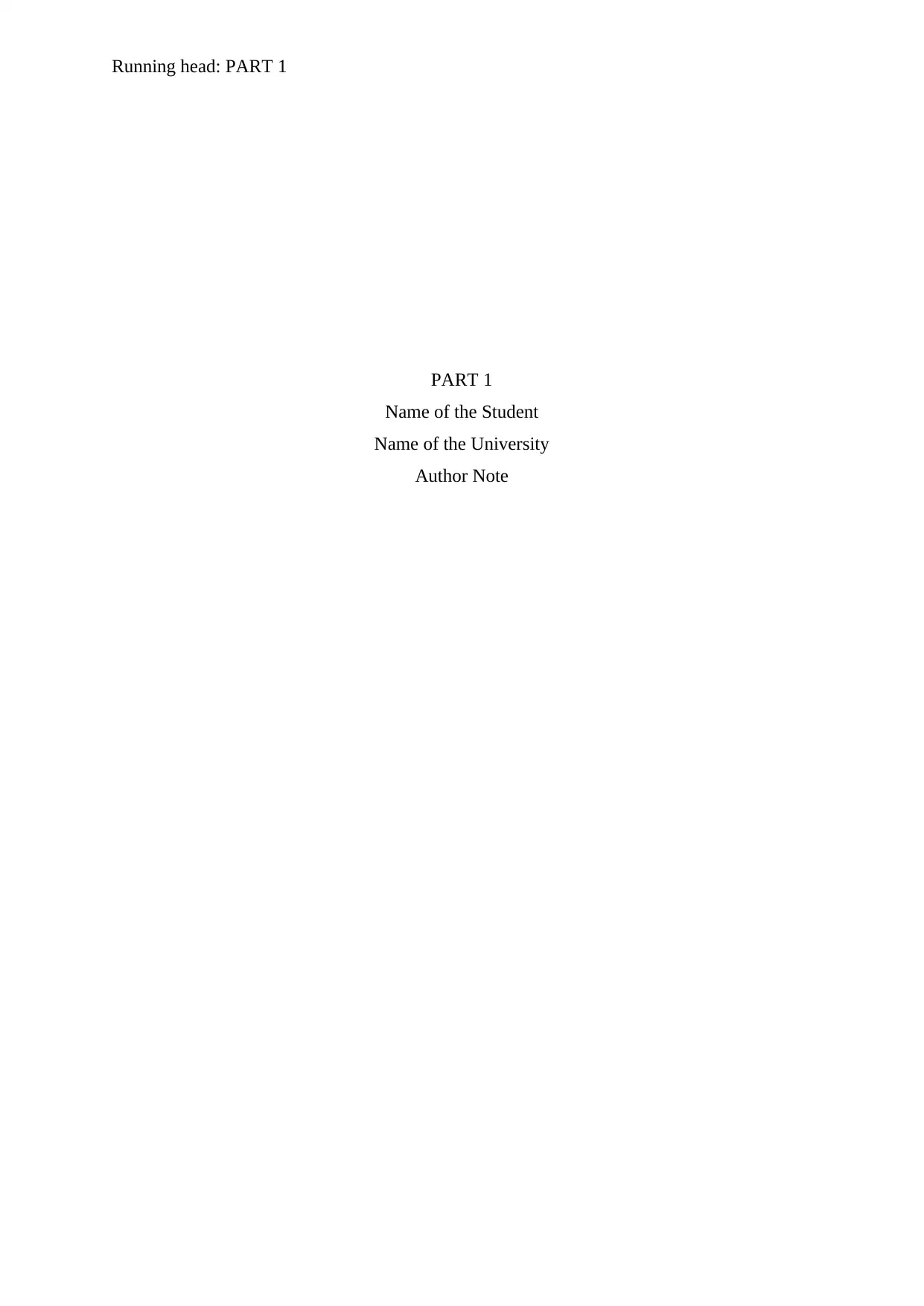
Running head: PART 1
PART 1
Name of the Student
Name of the University
Author Note
PART 1
Name of the Student
Name of the University
Author Note
Paraphrase This Document
Need a fresh take? Get an instant paraphrase of this document with our AI Paraphraser
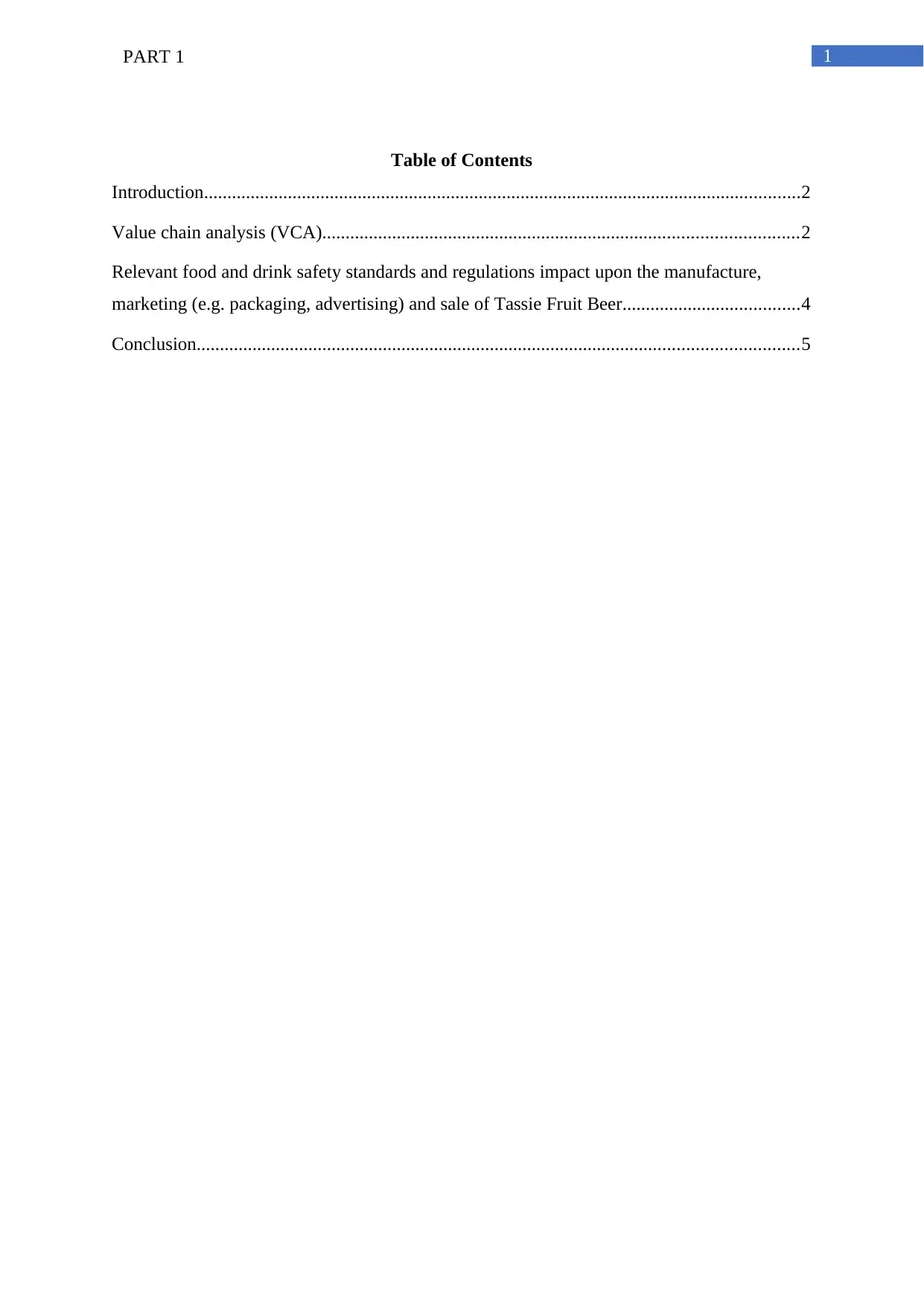
1PART 1
Table of Contents
Introduction................................................................................................................................2
Value chain analysis (VCA)......................................................................................................2
Relevant food and drink safety standards and regulations impact upon the manufacture,
marketing (e.g. packaging, advertising) and sale of Tassie Fruit Beer......................................4
Conclusion.................................................................................................................................5
Table of Contents
Introduction................................................................................................................................2
Value chain analysis (VCA)......................................................................................................2
Relevant food and drink safety standards and regulations impact upon the manufacture,
marketing (e.g. packaging, advertising) and sale of Tassie Fruit Beer......................................4
Conclusion.................................................................................................................................5
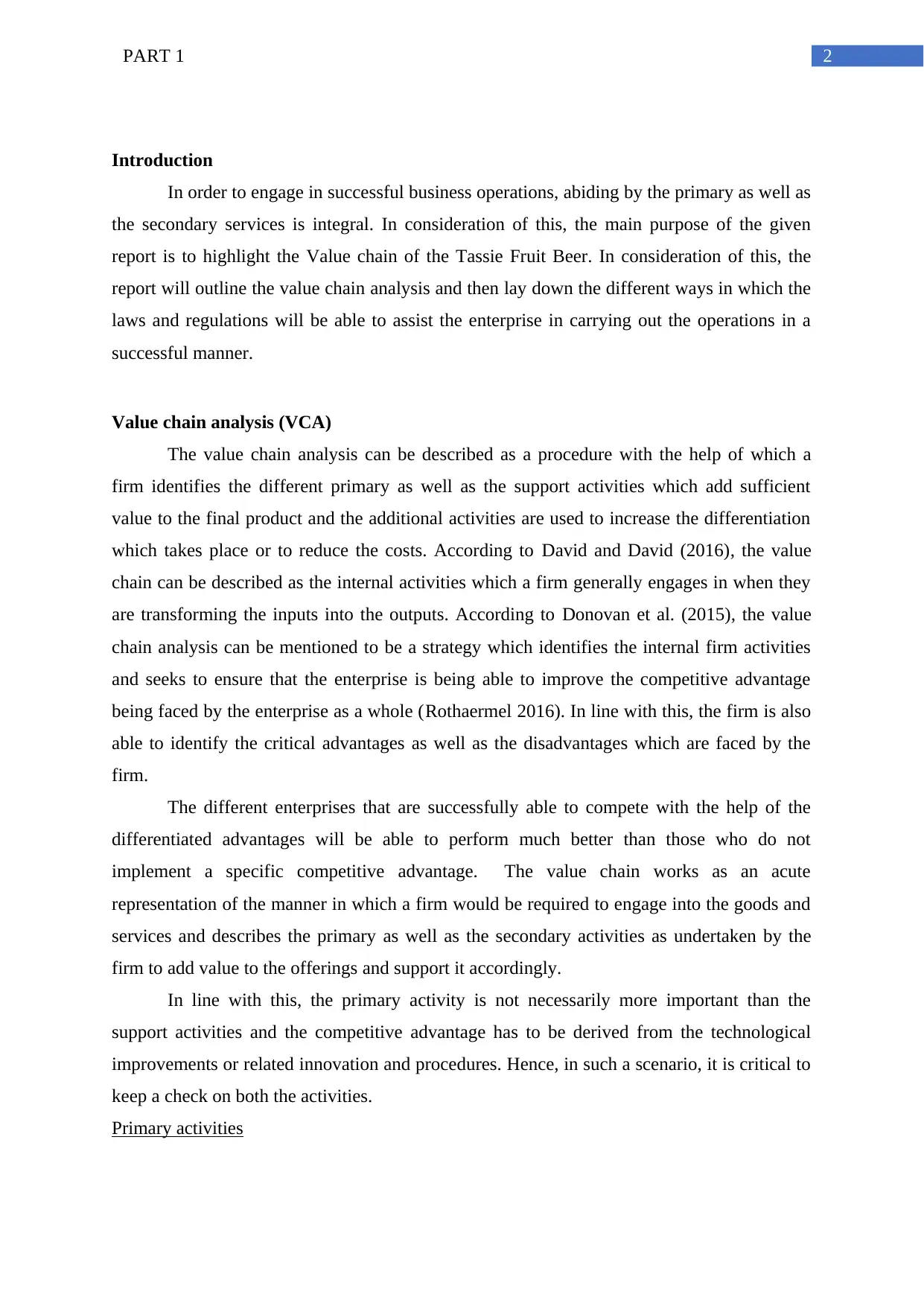
2PART 1
Introduction
In order to engage in successful business operations, abiding by the primary as well as
the secondary services is integral. In consideration of this, the main purpose of the given
report is to highlight the Value chain of the Tassie Fruit Beer. In consideration of this, the
report will outline the value chain analysis and then lay down the different ways in which the
laws and regulations will be able to assist the enterprise in carrying out the operations in a
successful manner.
Value chain analysis (VCA)
The value chain analysis can be described as a procedure with the help of which a
firm identifies the different primary as well as the support activities which add sufficient
value to the final product and the additional activities are used to increase the differentiation
which takes place or to reduce the costs. According to David and David (2016), the value
chain can be described as the internal activities which a firm generally engages in when they
are transforming the inputs into the outputs. According to Donovan et al. (2015), the value
chain analysis can be mentioned to be a strategy which identifies the internal firm activities
and seeks to ensure that the enterprise is being able to improve the competitive advantage
being faced by the enterprise as a whole (Rothaermel 2016). In line with this, the firm is also
able to identify the critical advantages as well as the disadvantages which are faced by the
firm.
The different enterprises that are successfully able to compete with the help of the
differentiated advantages will be able to perform much better than those who do not
implement a specific competitive advantage. The value chain works as an acute
representation of the manner in which a firm would be required to engage into the goods and
services and describes the primary as well as the secondary activities as undertaken by the
firm to add value to the offerings and support it accordingly.
In line with this, the primary activity is not necessarily more important than the
support activities and the competitive advantage has to be derived from the technological
improvements or related innovation and procedures. Hence, in such a scenario, it is critical to
keep a check on both the activities.
Primary activities
Introduction
In order to engage in successful business operations, abiding by the primary as well as
the secondary services is integral. In consideration of this, the main purpose of the given
report is to highlight the Value chain of the Tassie Fruit Beer. In consideration of this, the
report will outline the value chain analysis and then lay down the different ways in which the
laws and regulations will be able to assist the enterprise in carrying out the operations in a
successful manner.
Value chain analysis (VCA)
The value chain analysis can be described as a procedure with the help of which a
firm identifies the different primary as well as the support activities which add sufficient
value to the final product and the additional activities are used to increase the differentiation
which takes place or to reduce the costs. According to David and David (2016), the value
chain can be described as the internal activities which a firm generally engages in when they
are transforming the inputs into the outputs. According to Donovan et al. (2015), the value
chain analysis can be mentioned to be a strategy which identifies the internal firm activities
and seeks to ensure that the enterprise is being able to improve the competitive advantage
being faced by the enterprise as a whole (Rothaermel 2016). In line with this, the firm is also
able to identify the critical advantages as well as the disadvantages which are faced by the
firm.
The different enterprises that are successfully able to compete with the help of the
differentiated advantages will be able to perform much better than those who do not
implement a specific competitive advantage. The value chain works as an acute
representation of the manner in which a firm would be required to engage into the goods and
services and describes the primary as well as the secondary activities as undertaken by the
firm to add value to the offerings and support it accordingly.
In line with this, the primary activity is not necessarily more important than the
support activities and the competitive advantage has to be derived from the technological
improvements or related innovation and procedures. Hence, in such a scenario, it is critical to
keep a check on both the activities.
Primary activities
⊘ This is a preview!⊘
Do you want full access?
Subscribe today to unlock all pages.

Trusted by 1+ million students worldwide
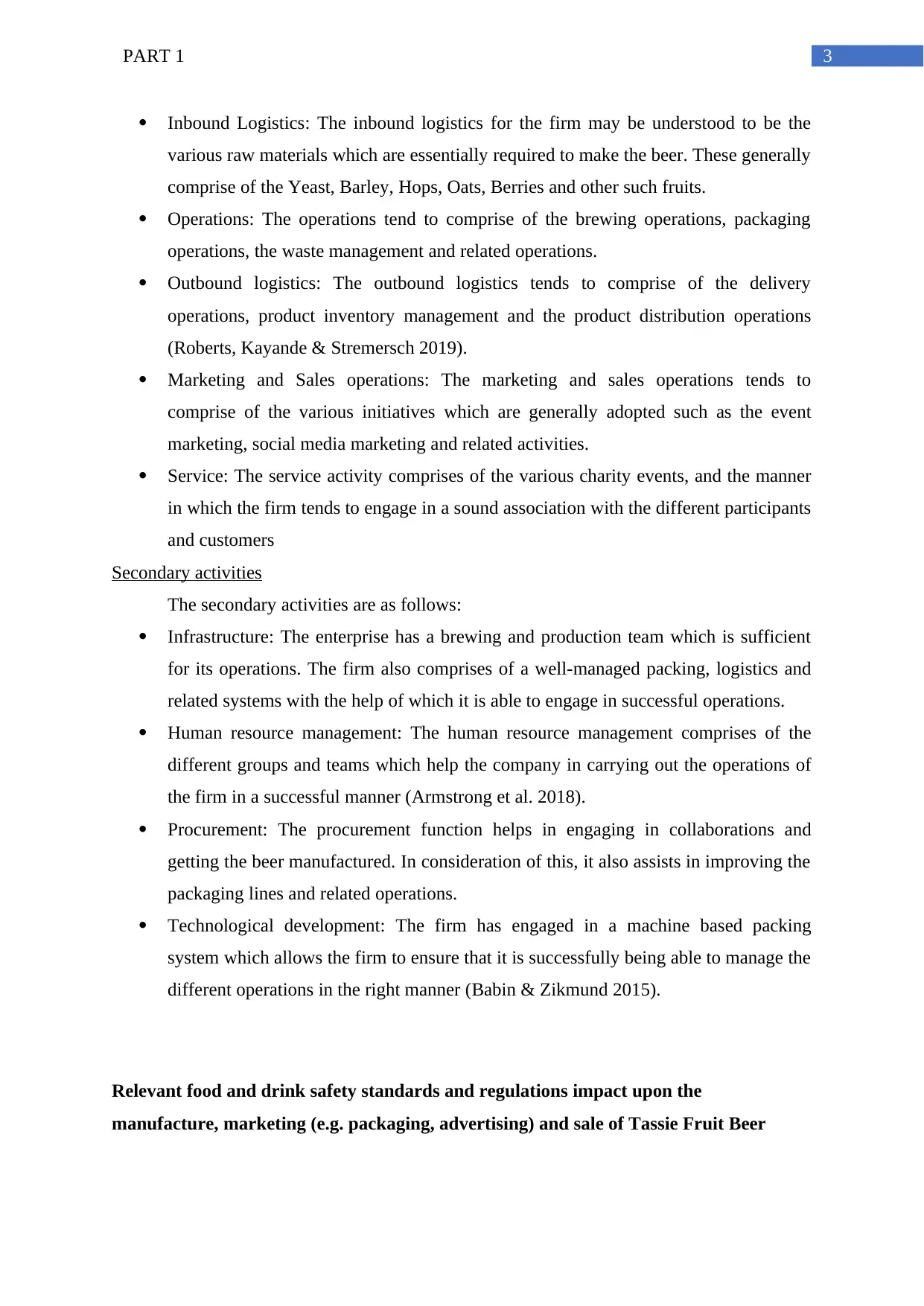
3PART 1
Inbound Logistics: The inbound logistics for the firm may be understood to be the
various raw materials which are essentially required to make the beer. These generally
comprise of the Yeast, Barley, Hops, Oats, Berries and other such fruits.
Operations: The operations tend to comprise of the brewing operations, packaging
operations, the waste management and related operations.
Outbound logistics: The outbound logistics tends to comprise of the delivery
operations, product inventory management and the product distribution operations
(Roberts, Kayande & Stremersch 2019).
Marketing and Sales operations: The marketing and sales operations tends to
comprise of the various initiatives which are generally adopted such as the event
marketing, social media marketing and related activities.
Service: The service activity comprises of the various charity events, and the manner
in which the firm tends to engage in a sound association with the different participants
and customers
Secondary activities
The secondary activities are as follows:
Infrastructure: The enterprise has a brewing and production team which is sufficient
for its operations. The firm also comprises of a well-managed packing, logistics and
related systems with the help of which it is able to engage in successful operations.
Human resource management: The human resource management comprises of the
different groups and teams which help the company in carrying out the operations of
the firm in a successful manner (Armstrong et al. 2018).
Procurement: The procurement function helps in engaging in collaborations and
getting the beer manufactured. In consideration of this, it also assists in improving the
packaging lines and related operations.
Technological development: The firm has engaged in a machine based packing
system which allows the firm to ensure that it is successfully being able to manage the
different operations in the right manner (Babin & Zikmund 2015).
Relevant food and drink safety standards and regulations impact upon the
manufacture, marketing (e.g. packaging, advertising) and sale of Tassie Fruit Beer
Inbound Logistics: The inbound logistics for the firm may be understood to be the
various raw materials which are essentially required to make the beer. These generally
comprise of the Yeast, Barley, Hops, Oats, Berries and other such fruits.
Operations: The operations tend to comprise of the brewing operations, packaging
operations, the waste management and related operations.
Outbound logistics: The outbound logistics tends to comprise of the delivery
operations, product inventory management and the product distribution operations
(Roberts, Kayande & Stremersch 2019).
Marketing and Sales operations: The marketing and sales operations tends to
comprise of the various initiatives which are generally adopted such as the event
marketing, social media marketing and related activities.
Service: The service activity comprises of the various charity events, and the manner
in which the firm tends to engage in a sound association with the different participants
and customers
Secondary activities
The secondary activities are as follows:
Infrastructure: The enterprise has a brewing and production team which is sufficient
for its operations. The firm also comprises of a well-managed packing, logistics and
related systems with the help of which it is able to engage in successful operations.
Human resource management: The human resource management comprises of the
different groups and teams which help the company in carrying out the operations of
the firm in a successful manner (Armstrong et al. 2018).
Procurement: The procurement function helps in engaging in collaborations and
getting the beer manufactured. In consideration of this, it also assists in improving the
packaging lines and related operations.
Technological development: The firm has engaged in a machine based packing
system which allows the firm to ensure that it is successfully being able to manage the
different operations in the right manner (Babin & Zikmund 2015).
Relevant food and drink safety standards and regulations impact upon the
manufacture, marketing (e.g. packaging, advertising) and sale of Tassie Fruit Beer
Paraphrase This Document
Need a fresh take? Get an instant paraphrase of this document with our AI Paraphraser
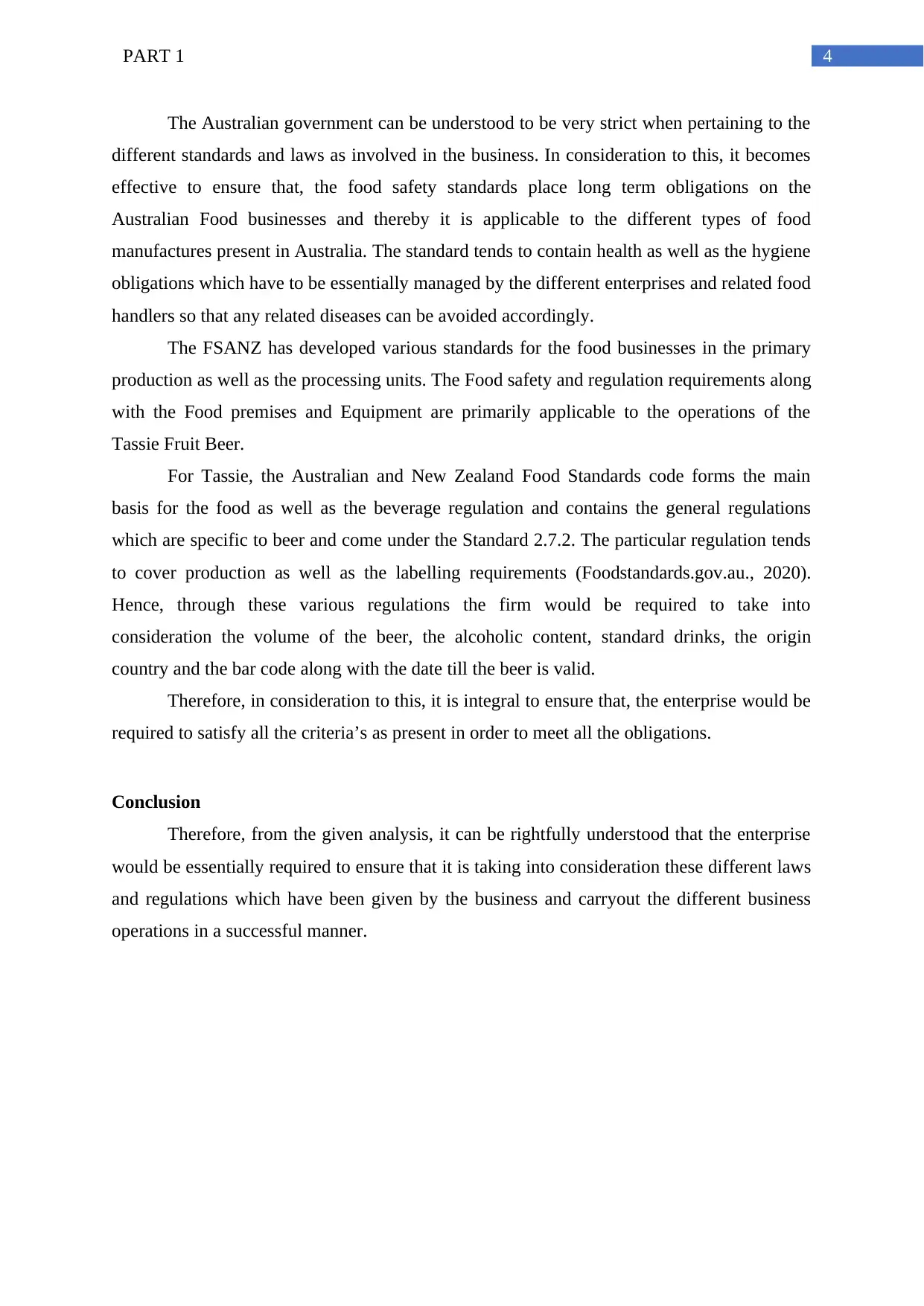
4PART 1
The Australian government can be understood to be very strict when pertaining to the
different standards and laws as involved in the business. In consideration to this, it becomes
effective to ensure that, the food safety standards place long term obligations on the
Australian Food businesses and thereby it is applicable to the different types of food
manufactures present in Australia. The standard tends to contain health as well as the hygiene
obligations which have to be essentially managed by the different enterprises and related food
handlers so that any related diseases can be avoided accordingly.
The FSANZ has developed various standards for the food businesses in the primary
production as well as the processing units. The Food safety and regulation requirements along
with the Food premises and Equipment are primarily applicable to the operations of the
Tassie Fruit Beer.
For Tassie, the Australian and New Zealand Food Standards code forms the main
basis for the food as well as the beverage regulation and contains the general regulations
which are specific to beer and come under the Standard 2.7.2. The particular regulation tends
to cover production as well as the labelling requirements (Foodstandards.gov.au., 2020).
Hence, through these various regulations the firm would be required to take into
consideration the volume of the beer, the alcoholic content, standard drinks, the origin
country and the bar code along with the date till the beer is valid.
Therefore, in consideration to this, it is integral to ensure that, the enterprise would be
required to satisfy all the criteria’s as present in order to meet all the obligations.
Conclusion
Therefore, from the given analysis, it can be rightfully understood that the enterprise
would be essentially required to ensure that it is taking into consideration these different laws
and regulations which have been given by the business and carryout the different business
operations in a successful manner.
The Australian government can be understood to be very strict when pertaining to the
different standards and laws as involved in the business. In consideration to this, it becomes
effective to ensure that, the food safety standards place long term obligations on the
Australian Food businesses and thereby it is applicable to the different types of food
manufactures present in Australia. The standard tends to contain health as well as the hygiene
obligations which have to be essentially managed by the different enterprises and related food
handlers so that any related diseases can be avoided accordingly.
The FSANZ has developed various standards for the food businesses in the primary
production as well as the processing units. The Food safety and regulation requirements along
with the Food premises and Equipment are primarily applicable to the operations of the
Tassie Fruit Beer.
For Tassie, the Australian and New Zealand Food Standards code forms the main
basis for the food as well as the beverage regulation and contains the general regulations
which are specific to beer and come under the Standard 2.7.2. The particular regulation tends
to cover production as well as the labelling requirements (Foodstandards.gov.au., 2020).
Hence, through these various regulations the firm would be required to take into
consideration the volume of the beer, the alcoholic content, standard drinks, the origin
country and the bar code along with the date till the beer is valid.
Therefore, in consideration to this, it is integral to ensure that, the enterprise would be
required to satisfy all the criteria’s as present in order to meet all the obligations.
Conclusion
Therefore, from the given analysis, it can be rightfully understood that the enterprise
would be essentially required to ensure that it is taking into consideration these different laws
and regulations which have been given by the business and carryout the different business
operations in a successful manner.
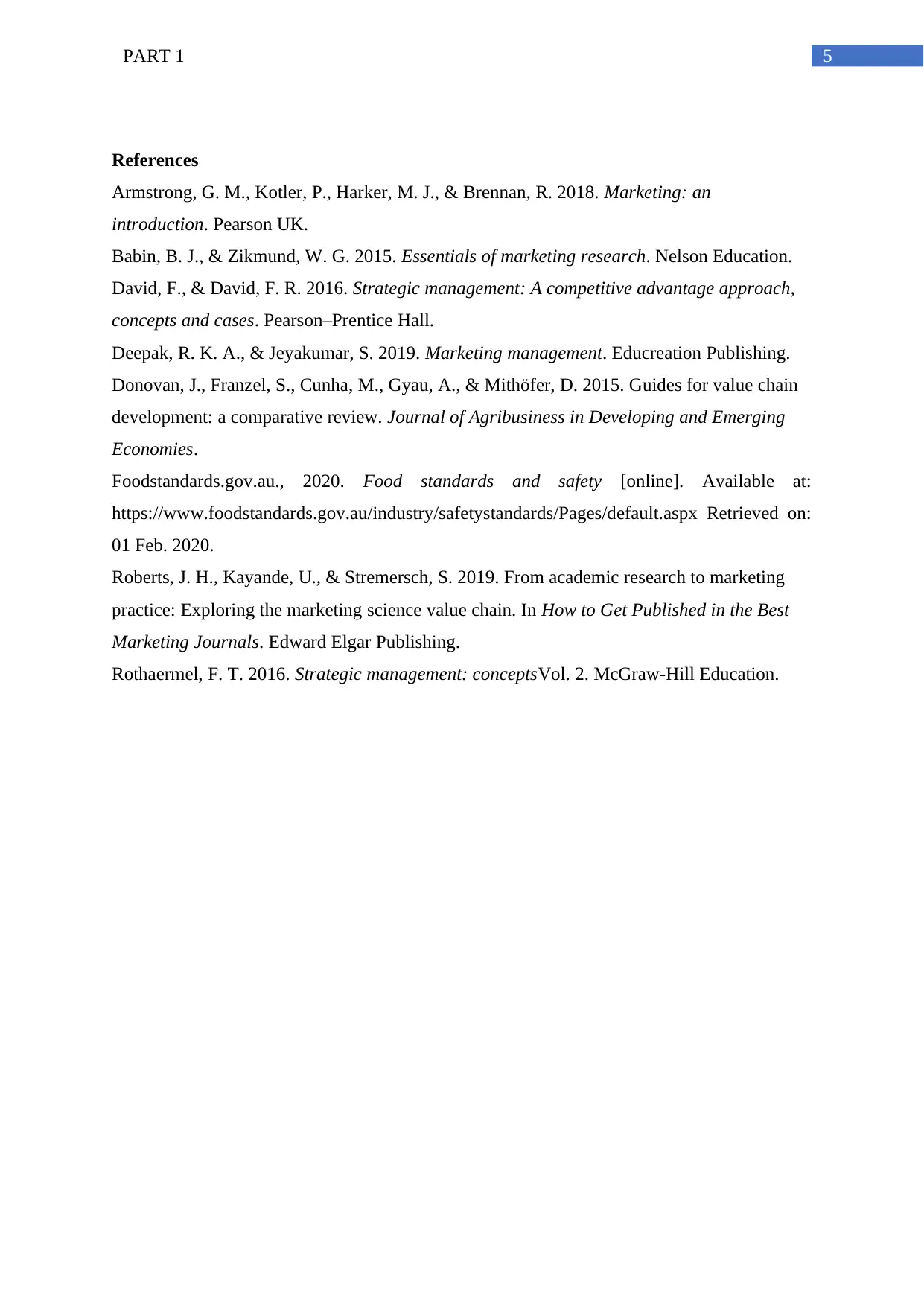
5PART 1
References
Armstrong, G. M., Kotler, P., Harker, M. J., & Brennan, R. 2018. Marketing: an
introduction. Pearson UK.
Babin, B. J., & Zikmund, W. G. 2015. Essentials of marketing research. Nelson Education.
David, F., & David, F. R. 2016. Strategic management: A competitive advantage approach,
concepts and cases. Pearson–Prentice Hall.
Deepak, R. K. A., & Jeyakumar, S. 2019. Marketing management. Educreation Publishing.
Donovan, J., Franzel, S., Cunha, M., Gyau, A., & Mithöfer, D. 2015. Guides for value chain
development: a comparative review. Journal of Agribusiness in Developing and Emerging
Economies.
Foodstandards.gov.au., 2020. Food standards and safety [online]. Available at:
https://www.foodstandards.gov.au/industry/safetystandards/Pages/default.aspx Retrieved on:
01 Feb. 2020.
Roberts, J. H., Kayande, U., & Stremersch, S. 2019. From academic research to marketing
practice: Exploring the marketing science value chain. In How to Get Published in the Best
Marketing Journals. Edward Elgar Publishing.
Rothaermel, F. T. 2016. Strategic management: conceptsVol. 2. McGraw-Hill Education.
References
Armstrong, G. M., Kotler, P., Harker, M. J., & Brennan, R. 2018. Marketing: an
introduction. Pearson UK.
Babin, B. J., & Zikmund, W. G. 2015. Essentials of marketing research. Nelson Education.
David, F., & David, F. R. 2016. Strategic management: A competitive advantage approach,
concepts and cases. Pearson–Prentice Hall.
Deepak, R. K. A., & Jeyakumar, S. 2019. Marketing management. Educreation Publishing.
Donovan, J., Franzel, S., Cunha, M., Gyau, A., & Mithöfer, D. 2015. Guides for value chain
development: a comparative review. Journal of Agribusiness in Developing and Emerging
Economies.
Foodstandards.gov.au., 2020. Food standards and safety [online]. Available at:
https://www.foodstandards.gov.au/industry/safetystandards/Pages/default.aspx Retrieved on:
01 Feb. 2020.
Roberts, J. H., Kayande, U., & Stremersch, S. 2019. From academic research to marketing
practice: Exploring the marketing science value chain. In How to Get Published in the Best
Marketing Journals. Edward Elgar Publishing.
Rothaermel, F. T. 2016. Strategic management: conceptsVol. 2. McGraw-Hill Education.
⊘ This is a preview!⊘
Do you want full access?
Subscribe today to unlock all pages.

Trusted by 1+ million students worldwide
1 out of 6
Related Documents
Your All-in-One AI-Powered Toolkit for Academic Success.
+13062052269
info@desklib.com
Available 24*7 on WhatsApp / Email
![[object Object]](/_next/static/media/star-bottom.7253800d.svg)
Unlock your academic potential
Copyright © 2020–2025 A2Z Services. All Rights Reserved. Developed and managed by ZUCOL.





